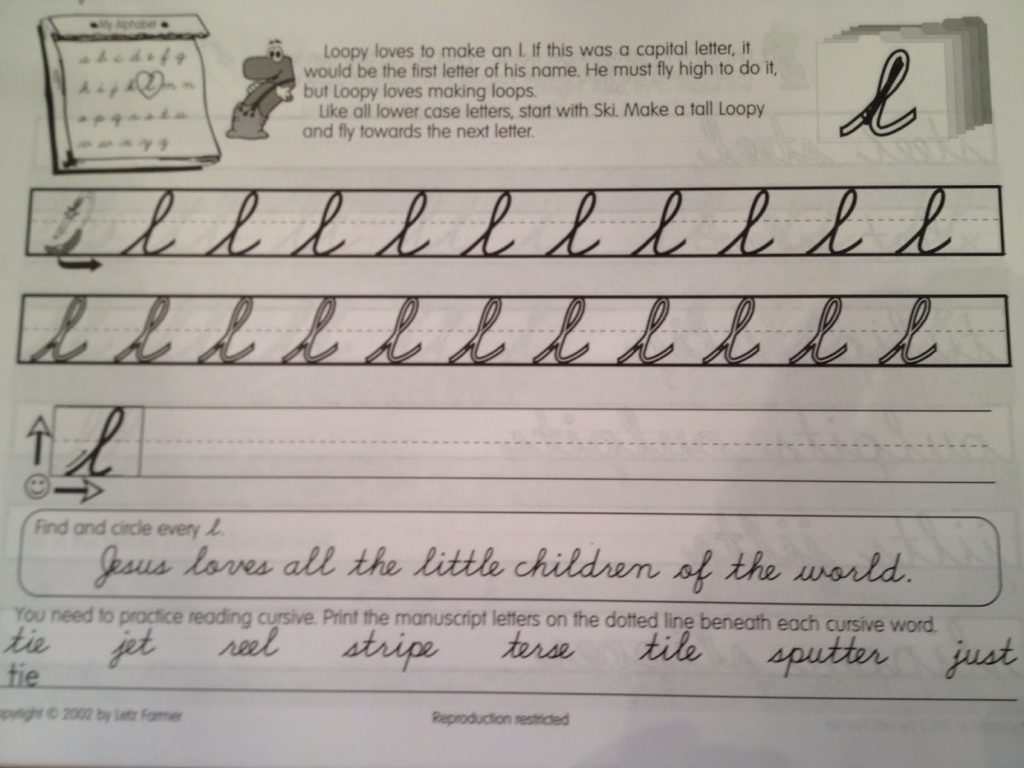Handwriting was one of those things I thought would just happen. I didn’t expect to have to actually teach it. I even wondered if it mattered. You know–everything’s done on a keyboard these days. But I’ve discovered that it does matter.
When your child is slow and insecure about handwriting, he will likely be slow in completing homework, too. Unless things change, the writing portion of college entrance exams will still have to be handwritten. And believe me, your child will be taking these in no time if my experience is any guide.
The Mastery Approach
At a certain point, I realized that my son’s handwriting wasn’t developing with standard workbook practice. I couldn’t read it and my mom wondered why he wasn’t writing in cursive yet. I switched to a popular handwriting curriculum that prevents upset kids. The idea is that there’s a skill set required for handwriting and with some simple guidance, kids can master it.
My son’s handwriting improved and I started using the new teacher-directed approach with all my kids. But I still wasn’t satisfied. I had to purchase new workbooks every year and their progress seemed designed to have a slow, public school pace. I started wondering if there was a curriculum that used the same idea (that letters had parts that could be consistently created), but taught the mastery of handwriting in one book? I found it!
Happy Handwriting and Cheerful Cursive are lesser known gems in the treasure of handwriting curriculum. Not only do these comb-bound volumes cover all the handwriting skills your child needs to be taught, but they can be photocopied to use with your entire family. I prefer to buy a copy for each child because they’re economically priced.
Kids Love It
Not only am I happy having to purchase just one book each for manuscript and cursive handwriting, but my kids love doing handwriting. Here’s why:
+Lots of opportunity for the youngest writers to trace and then fill in the letters
+Cute letter characters are engaging
+Constant review of the alphabet helps young students put writing skills to the test
+Includes phonics activities with manuscript practice
+Teaches recognition of letters written in many different styles
+Includes real world handwriting exercises like envelope addressing
How to Have Happy Handwriting
I purchased my curriculum, so this review is completely unbiased. You can purchase it, too, by checking out the handwriting page at Mastery Publications and then printing and mailing the order form. But I’m thrilled that the nice folks at Mastery Publications have generously offered a copy of both books for me to give away to one blessed reader (valued at over $35 with shipping). I’m praying that just the right homeschooler will win. Please enter the Rafflecopter giveaway below and share it with your friends.
What most appeals to you about this handwriting curriculum?


a Rafflecopter giveaway












It has a little bit of everything.
It looks great; like it could really make handwriting fun! 🙂
I love the multi-subject approach. Thank you!
The possibility that my son might enjoy it. 🙂
This looks great and not overwhelming. My kids might do it without much complaining!!!
I like that it gives lots of opportunities for tracing!
I like the Christian content of the program and the multi-subject aspect of it. This looks like a great handwriting program that my kids would enjoy!
I like the way the pages are laid out. My son really struggles with writing and hates it, we’ve been trying to find a better way to teach it to him.
Looks like something my daughter might like.
Thanks for the review! If the curriculum you tried is what I think it is the school I wa a para at used it. It sounds a lot like it, and worked great…. For a classroom full of kids, unless of course they didn’t learn at the avg pace :(. This looks great and I would love to start using this for tear free handwriting kin the fall when w start kindergarten!
Sara, you’re thinking of the right curriculum. I think your kindergartner would like it. Mine did!
I like that it is aChrist-centered curriculum. that is really appealing to me.
My son has been using HWT and his writing is still very sloppy. I have been looking for something else. This looks like it might be worth a try.
Deanna, I’ve found that they need more than just a workbook to really improve speed and clarity. I’ll be writing about that in the future. 🙂 Thanks so much for your comment.
Hopefully will help dd, who has very bad handwriting.
I like the real world application.
tarter95 at hotmail dot com
My daughter has been beggin me to learn cursive and I had no idea where to start! This looks fun and engaging and perfect for her!!
I like that it looks like it engages the child and isn’t boring at first glance.
I love how comprehensive it seems. One of mine really dislikes handwriting, and I think this would make it better.
We hired an Occupational Therapist to help our son with handwriting. The testing for ADHD brought to light a visual-motor processing problem. Very glad we hired her! (Yes, he has ADHD. It turns out that many kids with ADHD also have problems with handwriting.)
The OT used Loops and Groups for cursive. I liked it. It groups letters well, and breaks things into small steps. She also had him write large (12″ high on a white board), then smaller (6″ high in sand), then finally with pen on whatever size lines were comfortable for him. She had him sort letters into grass (a,c,e), sky (b,d) and ground (g,j), to ensure he knew how to position the letters, and had him write many rows of “Transformer blasts!” (lines, then circles, from top to bottom, then from middle to bottom) to fix those positions. (Not all in one sitting, and with many intermediate rewards. Age appropriate.)
In the end, we agreed that his handwriting was never going to do the job, even though it had improved somewhat. He would concentrate on using as few words as possible rather than getting his thoughts down. Mind-maps, outlines and rough drafts were torture, knowing he’d just have to write the same things over again in the good copy.
Since we switched to the laptop, and insisted he reach 20wpm, his written output has blossomed. (When he started, it was more work to type. He liked Ten Thumbs Typing, but it’s no longer available. Our daughter liked Dance Mat Typing.)
We tried Handwriting Without Tears with our daughter, whose problems aren’t as severe, and didn’t like it. The shapes aren’t hand-friendly. HWT has a system of evaluating kids’ handwriting skills, but they only offer training to teachers and other professionals.
If we had it to do over, or if either wants to tackle it again as an adult, we’d try Getty-Dubay (www.handwritingsuccess.com). It teaches hand-friendly italic instead of printing. No more perfect circles and vertical lines! They have a multi-book program for kids, and a single-book program for adults, as well as DVDs showing how to form the letters.
Thanks to the alert tester, the school loaned him a laptop with word processing and speech recognition software. (He finds it easier to type than train the speech recognition software, which is good. It’s hard to take meeting notes with the latter.) He’s entitled to extra time in the resource room for all tests, and even a “scribe” if necessary. Teachers cannot dock marks for handwriting. (I’ve told them to use common sense. A quiz or short-answer test doesn’t need a trip to the resource room, and “messy” is not the same as “can’t tell if he spelled it correctly.” They’re experimenting. That includes some failures that he’s learning from. Currently, the teachers have to push him to use it, because he doesn’t want to make the extra effort or to stand out.)
At university, _including_the_application_, he’s entitled to the same accommodations.
The C.Psych.Assoc. who did the tests also works with home schoolers, so they have everything in place when they join the standard system. And she works with kids in university who have never been tested before.
It’s worth researching before choosing a tester. Talk to the guidance office in your local high school and college. Several professionals in Ontario with the correct qualifications don’t know the “magic language” for the local board and which extra tests are needed. I’ve seen teachers almost cry over it — the kid clearly needs help, the parents did what they thought was right, and the school board won’t accept it.
Also, and this goes without saying for home schoolers, don’t wait for the school to suggest it. The waiting list for the tests are very long, and they’re expensive. However, once the right tests are done and the right words are used on the right reports, they have to make appropriate accommodations.
He wants to be a robotics engineer, and odds are good he’ll make it. If we hadn’t done all this, the college fund would have gone to waste.
Very long reply, but short compared to the difference it’s made to our son.
Thanks so much for sharing what you learned from your son’s experience, Cricket. I’m sure it will be helpful to other moms!